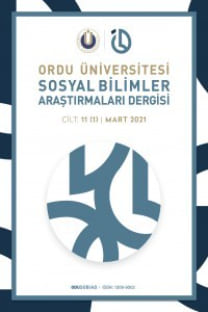(Western)Word / (Eastern)Image in My Name is Red: An Imagological Reading of Orhan Pamuk’s Ekphrastic Reimagination
Bu çalışmanın amacı, Orhan Pamuk’un Benim Adım Kırmızı romanını görsel yansıtma biçimlerinin ve Osmanlı minyatür eserlerinin konu edildiği imgemetin ve ekfrastik anlatı olarak incelemektir. Pamuk’un bu eserinde ekfrastik anlatı, Osmanlı ve İranlı üstatların minyatürlerinde yer alan imgelerin roman karakterlerine ve anlatıcılarına dönüşmesi ve bu sayede sürdürdükleri sanat ve gerçeklik ilişkisi üzerine tartışmalarıyla gerçekleşir. Romanda farklı anlatıcı-karakterler, 16. Yüzyıl Osmanlı minyatür resmi ve aynı dönemlerde Batı resim sanatında en bilinen örneklerini veren perspektifi ikili karşıtlık olarak tartışır. Böylece görsel olan romanda anlatının konusu haline gelir. İmge ve söz arasındaki ayrımın netliğini kaybettiği ve her ikisinin de hiyerarşik olmayan bir düzlemde yer aldığı Benim Adım Kırmızı, imgemetin kavramına örnek oluşturur. Ayrıca Pamuk’un bu romanı imgesel olanın yazılı metne aktarıldığı göstergeler arası bir çeviri olarak da değerlendirilir. Romanda, Frenk ya da Venedik üslubu olarak adlandırılan Rönesans perspektif kullanımı objektif gerçekliğe en yakın yansıtma biçimi olarak görülür. Minyatür ise resmettiği nesnelerin gerçeğine benzemeleriyle değil, “anlamı” yansıtma çabası bakımından daha üstün olarak görülür. Romanın konusunu oluşturan bu iki sanat türünün ve onların gerçekliği görme biçimlerinin Doğu-Batı zıtlığı içerisinde sunulması, “biz ve öteki” imgelerinin yeniden şekil aldığı farklı okumalara açar. İmgebilimin de konusunu oluşturan bu türden kimlik çalışmalarının dinamiğini belirleyen öz ve ötekini tanıma/tanımlama için imge yaratımı, Benim Adım Kırmızı adlı romanda birbirine karşıt olarak verilen görme ve resmetme biçimleri üzerinden tartışılmaktadır.
Anahtar Kelimeler:
Orhan Pamuk, ekfrasis, minyatür, imgebilim, Öteki, Benim Adım Kırmızı, kalıpyargı, imgemetin
(Western)Word / (Eastern)Image in My Name is Red: An Imagological Reading of Orhan Pamuk’s Ekphrastic Reimagination
This article aims to read Orhan Pamuk’s My Name is Red as an ekphrastic reimagination and the “imagetext” in which the visual representation is the object of the novelist’s verbal account of the sixteenth century miniature art and Renaissance perspectival painting shown in a diabolic opposition. Ekphrasis as the leading mode is also realized in the novel through incorporating certain figures and images from Ottoman and Persian miniatures as character narrators who in turn bring forth their individual comments on specific drawings in particular and on art’s relation to reality in general. In this new paradigm of the copresence of word and image in the novel, we are told the Frankish style of perspective is deemed closer to the outer reality than Islamic miniature, whereas miniature illustrations are intended to represent meaning rather than distinct objects themselves. The East-West dichotomy reshapes itself on a metaphorical level in Pamuk’s imagetext, suggesting imagological readings through this binarism between the two forms of the visual arts and their opposing ways of seeing and depicting the outer reality. The dynamic between the “self-image” defining the domestic, national identity and the “hetero-image” which typifies “the so-called Europeans” is reworked in My Name is Red on the very basis of the same conflict between the two dominant art forms.
Keywords:
Orhan Pamuk, ekphrasis, miniature, imagology, My Name is Red, hetero-image, self and other, imagetext,
___
- Göknar, E. (2006). Orhan Pamuk and the “Ottoman” theme, World Literature Today, 80.6, 34-38.
- Göknar, E. (2012). Occulted texts: Pamuk’s untranslated novels. Mehnaz M. Afridi and David M. Buyze (Eds). In Global perspectives on Orhan Pamuk (pp. 175-198). New York: Palgrave Macmillan.
- Göknar, E. (2013). Orhan Pamuk, secularism and blasphemy: The politics of the Turkish novel. New York: Routledge.
- Heffernan, J. A. W. (1993). Museum of words: The poetics of ekphrasis from Homer to Ashbery. London: The University of Chicago Press.
- Hutcheon, L. (1989). The poetics of postmodernism. New York: Routledge.
- Irvin, D. (2017). The ekphrastic detective: Readers, art and identity in My name is red. Sevinç Türkkan and David Damrosch (Eds). In Approaches to teaching the works of Orhan Pamuk (pp. 192-201). New York: Modern Language Association.
- Knopf, A. A. (2003). A conversation with Orhan Pamuk. The Borzoi Reader Online. Random House. http://www.randomhouse.com/knopf/authors/pamuk/qna.html.
- Leerssen, J. (2007). Imagology: History and method. Manfred Beller and Joep Leerssen (Eds.) In Imagology: The cultural construction and literary representation of national characters (pp. 17-32). Amsterdam, New York: Rodopi.
- Mitchell, W. J. T. (1987). Iconology: Image, text, ideology. Chicago: University of Chicago Press.
- Mitchell, W. J. T. (1994). Picture theory. Chicago: University of Chicago Press.
- Pamuk, O. (1998). My name is red (Erdağ Göknar, trans. 2001). London: Faber and Faber.
- Shaw, Y. O. (2014). Orhan Pamuk. Çimen Günay Erol and Burcu Alkan (Eds.). In The dictionary of literary biography, Vol. 373 (Turkish Novelists Since 1950) (pp. 243-268). Washington: Gale.
- Tanındı, Z. From the painting treasury of the Palace: Miniatures in Ottoman art, History of Istanbul, 7, 384-401. https://istanbultarihi.ist/637-from-the-painting-treasury-of-the-palace-miniatures-in-ottoman-art.
- Türkkan, S. (2017). Fiction, screenplay, and the museum of innocence. Sevinç Türkkan and David Damrosch (Eds). In Approaches to teaching the works of Orhan Pamuk (pp. 3-7). New York: Modern Language Association.
- Weststeijn, T. (2007). Visual arts. Manfred Beller and Joep Leerssen (Eds.) In Imagology: The cultural construction and literary representation of national characters (pp. 451-458). Amsterdam, New York: Rodopi.
- Zacharasiewicz, W. (2010). Imagology revisited. Amsterdam, New York: Rodopi.
- ISSN: 1309-9302
- Yayın Aralığı: Yılda 3 Sayı
- Başlangıç: 2010
- Yayıncı: -
Sayıdaki Diğer Makaleler
Mustafa Tuncer OKUMUŞ, İsmail BAKAN, Merve Rabia KUTLUK
Schwartz Değerler Ölçeği Bağlamında “Camdaki Kız” Dizisinin İçerik Analizi
Mehmet Ali BÜYÜKPARMAKSIZ, Yeşim ERMİŞ
Fatma Yelda GEZİCİOĞLU, Sevim Tuğba ARABALI KOŞAR, Mine BEŞEN YALÇIN
Türkiye ve Avrupa Ülkeleri Orman Yangınlarının Bazı Değişkenler Açısından Değerlendirilmesi
Covid-19 Pandemisinde Hijyen Davranışları ve Çevre İlişkisi: Ampirik Bir Çalışma
Zeynep KASAP ACUNGİL, Yavuz ACUNGİL
Kur’ân’ın Mucizevî Dili: Yeni Tanıklıklar
Temel Eğitim Yatırımlarının Değerlendirilmesi
